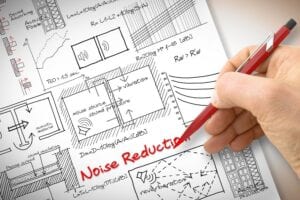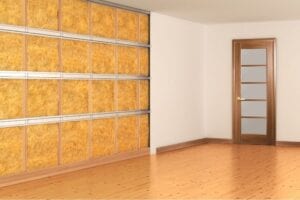Soundproofing your home is a topic that is becoming more popular.
As homes are built closer together, most new homes have lighter building materials like stud walls with gypsum board.
Noise levels can get loud.
People want to enjoy their homes without causing friction with neighbours due to noise complaints.
Noisy neighbours are the number one reason why people considering soundproofing.
Reasons Why People Need To Have Soundproofing
- Theatre rooms
- Home office
- bedrooms of young children
- Traffic noise or train track
- Under an aircraft flight path
- Shift workers
- Musicians
A well-soundproofed home will provide a more harmonious lifestyle and increase your home’s value when you want to sell it.
It will also be more energy-efficient to heat and cool.
What Soundproofing Does:
Enjoy your music or movies at any time without disturbing others.
You can work from home without disturbing the family or having general household noise interfering with your work on a conference call or webinar.
Get It Done During The Home Build
The simplest and cost-effective way to soundproof a room is to do it during the construction of your home or extension.
When you build your home or have a renovation done – Make sure you have better soundproofing methods and materials used.
The most common are acoustic plaster, soundproofing and mass elastic vinyl.
Suppose you need a soundproofed area, such as a recording studio. In that case, this will require additional planning as it is the equivalent of building a room within a room.
You need to understand that noise is generated by sound waves, which can be described as energy waves. That sound can be divided into two noise categories:
Airborne Or Impact Sound.
Airborne sound is just that: sound that is transmitted through the air.
Examples include people talking, television noise, traffic noise, appliances, music or dogs barking.
Impact sound is caused by objects hitting a surface in the home.
Closing doors, furniture being moved, and footsteps cause this on hard floors.
To stop or reduce sound transmission, we need to control the sound waves or try to minimise the energy/power of the waves.
The Basic Overview Of Soundproofing
First, inspect the walls for gaps or weak spots and use an acoustic sealant to seal any cracks.
Treat soundproofing like waterproofing, it is only as good as the weakest point.
The example we like to give is when you roll down your car window and hear a loud noise.
If you roll it back up and leave a small gap, the noise is still loud, but if you roll it up, it disappears).
Improve the mass of the wall by adding high mass/density products.
Improve the wall’s ability to absorb sound energy and vibration. Without this improvement, the added mass will have little effect.
Add acoustical insulation between wood battens to eliminate sound reverberation.

Use A Variety Of High Mass Materials.
Different materials are better suited for different sound frequencies, so a combination of high mass materials will perform better than using multiple materials of the same type.
Blocking: Try to prevent sound waves from entering an area. This can be done by double glazing windows, sealing cracks and holes in walls, and using door sweeps to prevent sound from penetrating under a door and around window frames.
Absorbing and Damping – These two terms are very similar. Absorb means it “soaks up” the sound vibrations – carpet, cork flooring, acoustic foam or ceiling insulation.
Dampening stops the energy wave by not vibrating and allowing it to go further. A solid wood door will work better than a particleboard door.
Decoupling: Separating the two sides of a structure so that they do not touch and the vibrations do not pass through to each other. It is very effective to isolate sound on one side of a wall and prevent sound from passing through to the other side.
What rooms need to be soundproofed?
Any room in your home that you think will benefit from it.
If you are building or renovating, you should have the foresight to install additional soundproofing products. It brings more comfort to any home when outside noise is blocked and the house has been acoustically treated.
Soundproofing A Recording Studio
If you want to build a professional recording studio or sound booth, you will build a “room within a room.”
The interior room has no physical connection to the external, and that’s what decoupling refers to. It prevents sound vibrations from passing through the walls and creating a sound interruption.
Both rooms use dense materials such as acoustic plasterboard, have acoustic insulation or foam between the walls. The room is sealed with acoustic sealant to ensure there are no gaps around the door frame to stop all unwanted noise and outside sounds.
Soundproofing a home theatre room
Soundproofing a home theatre room effectively can be done with acoustic gypsum board and noise resilient mounting clips.
This will create a sound barrier between the gypsum board and the stud framing.
Add extra sound absorption with suitable, high-quality carpets and upholstered furniture to reduce echos.
Soundproofing A Home Office:
When working from home, the last thing you need is unnecessary noise distracting you.
Loud neighbours, noisy kids, people mowing their lawns, or a barking dog can be a significant distraction and negatively impact your productivity.
For a home office, you can follow the same steps as for a home theatre above.
Soundproofing Bedrooms
A bedroom is a space where minimal noise is a must.
Minimal noise or disturbances are crucial to a good night’s sleep, and minimising outside noise will improve your sleep.
To soundproof bedrooms, you typically only need a medium-density acoustic insulation mat in the interior walls and a higher-density acoustic insulation mat in the exterior walls.
Use a draft stopper or door sweep on the bedroom door.
Typical gypsum board walls are not suitable for sound reduction because they are thin. The area between the boards and the wall cavity creates an echo chamber, allowing sound waves to bounce in the gap and pass through the wall studs and walls.
Depending on the level of soundproofing desired and the budget available, we recommend the following steps.
Option 1
To reduce sound in a room or area, – Think open plan. Use soft furnishings such as upholstered furniture, rugs, carpets and blackout curtains or drapes. All of this will help reduce the transmission of sound waves.
Floor coverings absorb sound, and curtains help block sound coming through windows.
Option 2
If this is not sufficient, you can add sound-absorbing ceiling tiles and exterior sound-absorbing acoustic tiles to the walls.
If you are considering carpeting, you can also place an acoustic underlayment on the floor. The extra step with the carpets will help if you live in an apartment with neighbours below you.
Option 3
If the noise comes from outside, such as living near a busy street or near noisy neighbours.
You’ll need to opt for a change in your walls and doors.
Add a layer of acoustic plasterboard over an existing wall and replace hollow doors with a solid-core door.
You should also add a draft stopper to prevent noise from passing under the door.
Option 4
The next step is to remove the current gypsum board, fill the wall cavity with acoustic wall insulation, and then re-plaster it with an acoustic gypsum board.
Option 5
Finally, suppose the highest level is needed. In that case, you will need to build an acoustic wall as described in Building a Recording Studio.
You will need a contractor to build a new wall frame that detached from the existing walls.
The wall cavities will be filled with the proper insulation and then covered with an acoustic gypsum board.
Mass elastic vinyl can also be used.
Remember that you will also need to line the floors with good quality carpeting and an acoustic underlayment.
Professional Advice And Construction
For more advice on how or what soundproofing material you should use to find an effective solution to excessive noise levels and soundproofing ideas
We can help with Brisbane Soundproofing techniques.
The Article Soundproofing Your Home was found on https://limitsofstrategy.com
The Article Soundproofing Your Home First Appeared ON
: https://gqcentral.co.uk


Comments are closed